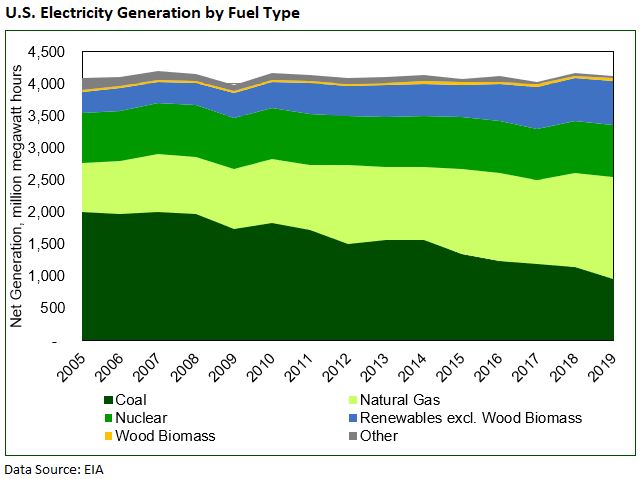This is the fifth in a series related to the Q3 2020 Forisk Research Quarterly (FRQ), which includes forest industry analysis and timber price forecasts for North America. The post includes excerpts from our wood bioenergy research.
Wood biomass continued to be a fairly stable, though small, component of total U.S. electricity generation in 2019. According to the EIA’s annual electric power data, wood biomass was 0.9% of total U.S. electricity generation (Figure). It has been, on average, 1.0% annually over the past 15 years. The 38.4 million megawatt hours generated from wood biomass in 2019 represented a 6.3% decline from 2018.

Wood biomass, as categorized by the EIA, is composed of black liquor, waste wood liquids (excluding black liquor), and waste wood solids. In 2019, wood solids, such as chips and bark, were 50.9% of total wood biomass generation; black liquor was 48.3%, and other wood liquids were 0.7%. In 2019, U.S. paper and paperboard production declined 4.5% while numerous wood-fired electricity generating facilities shut down or curtailed production under challenging market conditions. Impacts varied regionally with the Northeast particularly affected.
Wood-fired electricity generation faces numerous headwinds going forward. In addition to low natural gas prices―the U.S. Henry Hub benchmark reached a record low in the first half of 2020―the cost of renewable generation from wind and solar continues to decline. Excluding wood biomass, from 2005-2019 renewable generation increased 115%, driven by wind and solar. Additionally, the U.S. EPA’s new Affordable Clean Energy (ACE) rule, which provides emissions guidelines for states and replaces the Clean Power Plan (CPP), does not support co-firing as a path to emissions reductions. The ACE does not include biomass as a “Best System of Emission Reduction” (BSER), which defines the path towards lower emissions for existing power plants. The new ACE rule, like its predecessor, is unlikely to impact the use of wood biomass for electricity generation.
To download the most recent Wood Bioenergy Summary, click here.

Leave a Reply